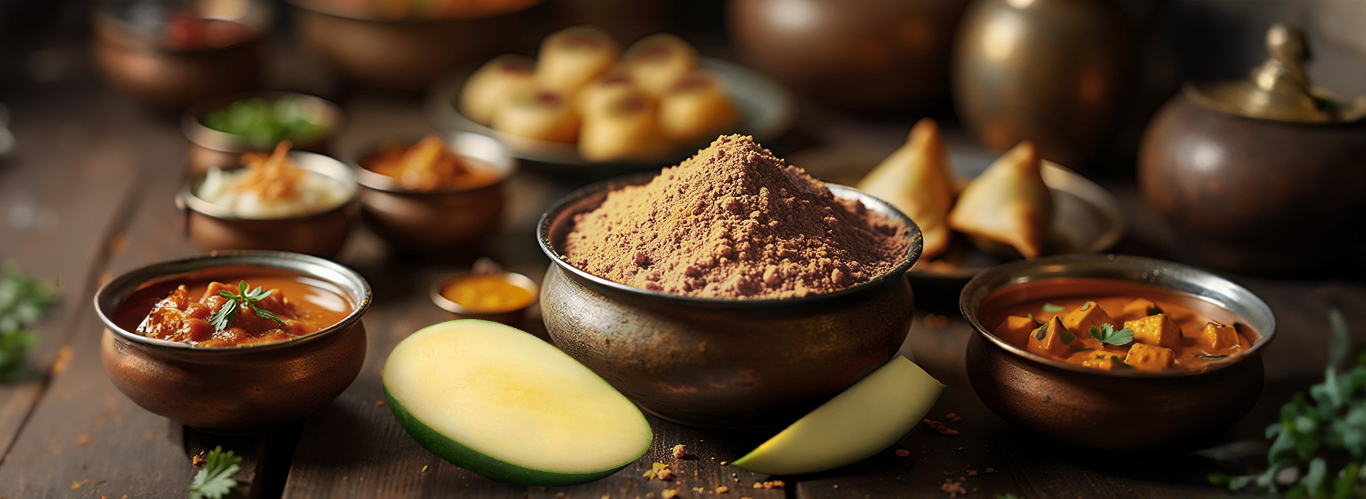Introduction
Ready to uncover a secret ingredient that’s been quietly revolutionising Indian cooking for centuries? This little-known spice is the reason your curries have that perfect balance of tanginess without a single drop of lemon or tamarind. It’s what brings a surprising zing to your chaats and an irresistible depth to your dals. We’re talking about amchur powder—the magical tang enhancer that every Indian kitchen swears by.
If you don’t know how to use amchur powder to make authentic Indian food at home, then this guide is your best bet. It will help you understand how amchur powder comes in handy during those times when you’re all out of fresh lemon. Once you discover the wonders of mango powder use, you will wonder how you ever cooked without this versatile little powder.
History and Origin of Amchur Powder
As wonderful as its flavour is, the story of making amchur powder is even more captivating. This spice dates back to northern India where mango trees grow throughout the year.
To ensure that they could indulge in the flavour of raw mangoes beyond the fruiting season, ancient cooks devised a brilliant solution: they harvested green mangoes, peeled and sliced them, dried them under the sun, and ground them into a fine powder. This way, amchur powder was used for enhancing dishes.
This fragrant, citrusy powder has become an essential mango powder in Indian cooking. Especially in vegetarian dishes, where it gives the needed tanginess that meat-based broths naturally offer. Amchur powder’s use in cooking has risen so much that it is a staple in Indian spice racks, adding zest to countless recipes.
Culinary Uses of Amchur Powder
So, how exactly can you incorporate this wonder spice into your meals? The uses of amchur powder are incredibly diverse:
- Curries and Gravies: A pinch of amchur powder lifts the flavours of lentil dals, chickpea curries, and rich tomato-based gravies.
- Street Food & Chaats: Ever wondered what gives pani puri, aloo chaat, and samosas their tantalising tang? It’s amchur at work!
- Dry Spice Blends & Marinades: Mixed with Jeera Powder and other spices, it makes an excellent coating for vegetables, paneer, and even meats.
- Vegetable Stir-Fries: Okra, potatoes, eggplant—almost any vegetable benefits from a little dusting of amchur powder towards the end of cooking.
- Soups & Stews: A dash of amchur powder balances out the richness in thick lentil soups and vegetable broths.
- Pickles & Chutneys: Many traditional Indian pickles and chutneys wouldn’t be the same without this tangy addition.
Looking for a recipe with amchur powder? Try adding it to your homemade spice blend for tandoori dishes—it complements smoky flavours beautifully!
How to Choose and Store Amchur Powder
Like any spice, quality matters when it comes to amchur powder used for cooking. Here’s how to ensure you’re getting the best:
- Opt for Sunrise Amchur Powder for a fine-textured, aromatic product made from high-quality green mangoes.
- Check for a beige to light brown colour—a dull or greyish hue may indicate age or low quality.
- Store it in an airtight container in a cool, dry place to retain its potency.
- Keep it away from direct sunlight and moisture to prevent clumping.
A fresh, well-preserved batch of amchur powder can last up to a year, but trust us, once you start using it, it won’t stick around that long!
Substitutes for Amchur Powder
If you ever run out of amchur powder, don’t panic. There are a few alternatives you can use in a pinch:
- Lemon Juice or Vinegar: These add sourness but also extra moisture, which may not work for all recipes.
- Tamarind Paste or Powder: Slightly stronger and more acidic, but a close match in terms of depth.
- Pomegranate Powder: A sweeter alternative that still provides a tangy edge.
- Citric Acid Powder: Works well in spice mixes, but use sparingly as it’s quite potent.
However, nothing quite replicates the unique balance of fruity and tangy flavours that mango powder uses bring to a dish!
Pro Tips for Using Amchur Powder
To get the most out of this versatile spice, keep these tips in mind:
- Use it towards the end of cooking: to preserve its bright, citrusy notes.
- Start with a pinch: amchur is potent, and a little goes a long way.
- Pair it wisely: it works exceptionally well with Jeera Powder and Ground Black Pepper to create rich, complex flavours.
- Experiment with it: Try it in fusion dishes like mango-flavoured dressings, roasted nuts, or even a sprinkle over popcorn for an unexpected twist.
Conclusion
Amchur powder is one of those quiet kitchen heroes—subtle yet essential, simple yet powerful. Whether you're whipping up a comforting dal, an irresistible street-style chaat, or a hearty sabzi, this spice brings an unmatched vibrancy to every bite.
At Sunrise Masala, we take pride in offering amchur powder made from handpicked raw mangoes, ensuring the perfect balance of tartness and depth. And when blended with the earthy warmth of Sunrise Jeera Powder and the bold kick of Sunrise Ground Black Pepper, your cooking reaches a whole new level of deliciousness. Discover the magic of pure, high-quality spices and bring authentic Indian flavours to your table!
FAQs
1. What are the best recipes that use mango powder?
Mango powder works splendidly in chana masala, dal tadka, aloo sabzi, and even tandoori spice rubs. The powder can also be added to chutneys and chaats for additional flavour.
2. Can amchur powder be used instead of lemon juice?
Absolutely! Amchur powder is an excellent dry substitute as it provides tanginess.
3. How long does amchur powder last?
Amchur powder stored in an airtight container away from heat and moisture can last for up to a year.
